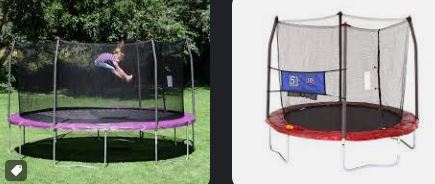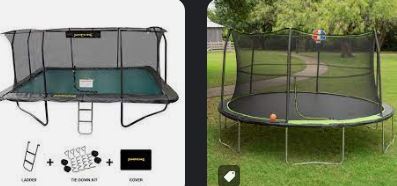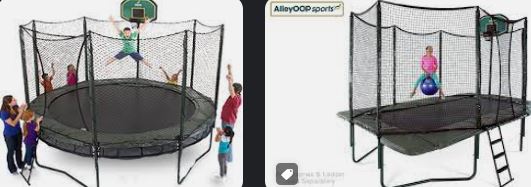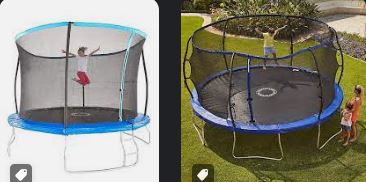Understanding Trampoline Weight Limits: A Comprehensive Guide. Jump Safe and High: Your Essential Guide to Trampoline Weight Limits. How to Choose a Trampoline: Weight Limits and Safety Tips
Welcome to this comprehensive guide on trampoline weight limits. As a trampoline enthusiast, safety is always our priority, and one key aspect is understanding your trampoline’s weight limit.
Main Trampoline Weight Limits
| Trampoline Size | Approximate Weight Limit (lbs) |
|---|---|
| 6ft – 10ft (Mini) | 200 – 250 |
| 12ft – 14ft (Mid-size) | 250 – 350 |
| 15ft – 16ft (Large) | 350 – 500+ |
What is a Trampoline Weight Limit?
A trampoline’s weight limit is the maximum weight it can safely support without the risk of damage or injury. This limit is hardly determined by several factors, including the trampoline’s size, the materials used in its construction, and the strength and number of its springs. It is essential to adhere to this limit to ensure both the trampoline’s longevity and its users’ safety.
Contents
- A Deep Dive into Trampoline Brands and Their Weight Limits
- Overview of Popular Trampoline Models and Their Weight Limits
- Weight Limits of Trampolines Based on Their Sizes
- Weight Limit Considerations for Different Trampoline Users
- High-Weight Limit Trampolines for Heavy-Duty Use
- Safety Measures and Trampoline Weight Limits
- Tips for Purchasing a Trampoline Considering Weight Limit
Why Trampolines Have Weight Limits
Trampolines have weight limits for two primary reasons: user safety and trampoline durability. From a safety perspective, exceeding the weight limit can lead to a higher and more severe risk of accidents and injuries. Overloading can cause the jumping mat to tear, the frame to bend or break, or the springs to detach. As for durability, consistently exceeding the weight limit can wear out the trampoline components faster, leading to a shorter lifespan.
What Happens When Weight Limits Are Exceeded?
Exceeding a trampoline’s weight limit can have immediate and long-term consequences. In the short term, the trampoline might lose its bounce quality, making it less enjoyable. Over time, parts may become strained and eventually break, which can result in a complete trampoline failure. It is not only damaging to the trampoline but also a significant safety risk to the user.
Tips for Keeping Within the Weight Limit
Keeping within the trampoline weight limit requires vigilance and routine checks. Always ensure you know the weight limit of your trampoline, and consider the weight of anyone who might be using it. Avoid simultaneous use if the combined weight of the users will exceed the limit. Regularly inspect your trampoline for any signs of wear or damage. Remember, if you’re in doubt, it’s better to err on the side of caution regarding trampoline safety.
A Deep Dive into Trampoline Brands and Their Weight Limits
The brand becomes influential as we navigate the wide world of trampolines. It isn’t just about reputation or cost, it’s also about the quality of their products, including the weight limits they set for their trampolines. Let’s look closer at the different brands in the market and how they size up regarding weight restrictions.
The High Weight Limit Trampoline Brands
A few brands come to mind immediately regarding high-weight limit trampolines. Brands such as Skywalker Trampolines, Zupapa Trampolines, and AlleyOOP Trampolines are notable for their focus on safety and durability, reflecting their relatively high weight limits.
Skywalker’s round trampolines, for instance, have weight limits ranging from 200 to 375 lbs. Zupapa and AlleyOOP models can withstand weight loads up to 375 to 800 lbs, making these trampolines perfect for multiple users or more substantial jumpers.
Trampoline Brands with More Moderate Weight Limits
Some brands offer more moderate weight limits. JumpKing and Sportspower trampolines are great examples, offering a range of models that support between 200 and 300 lbs.
Although these brands may have lower weight limits, this doesn’t necessarily imply a compromise on quality. Instead, these trampolines may be more suited to younger users or those who prefer to bounce solo.
Table Comparison of Different Brands’ Weight Limits
| Brand | Weight Limit Range (lbs) |
|---|---|
| Skywalker Trampolines | 200 – 375 |
| Zupapa Trampolines | 375 – 800 |
| AlleyOOP Trampolines | 375 – 800 |
| JumpKing Trampolines | 200 – 300 |
| Sportspower Trampolines | 200 – 300 |
Overview of Popular Trampoline Models and Their Weight Limits
When examining trampolines, it’s valuable to go beyond the brand and look closely at specific models. Each model within a brand can have a unique set of features and weight limits. Here, we’ll delve into some popular trampoline models and review their weight limits.
Skywalker Trampolines: Weight Limit Review

Skywalker is a well-established brand known for its quality trampolines. The Skywalker Trampolines 15-Foot Jump N’ Dunk Trampoline stands out among their many models. This trampoline has a fun basketball hoop and a weight limit of 200 lbs. Perfect for a fun and active afternoon for the younger family members.
Little Tikes Trampoline: Weight Limit Review
The Little Tikes 3′ trampoline is an excellent choice for toddlers and younger children. It is an indoor trampoline designed with safety and simplicity, perfect for burning off some energy. It has a weight limit of 55 lbs, making it suitable for single-child use.
Jumpking Trampolines: Weight Limit Review

JumpKing, a well-known name in the trampoline industry, offers the JumpKing 14ft trampoline, among other models. This robust and durable trampoline is ideal for older kids and adults, boasting a weight limit of 220 lbs.
Springfree Trampolines: Weight Limit Review
Springfree Trampoline, an innovative brand known for its springless design, brings the Springfree Jumbo Round Smart Trampoline forward. This unique trampoline uses flexible rods instead of springs, reducing the risk of injury. It’s an excellent choice for families, with a significant weight limit of 220 lbs.
| Model | Weight Limit (lbs) |
|---|---|
| Skywalker Trampolines 15-Foot Jump N’ Dunk Trampoline | 200 |
| Little Tikes 3′ Trampoline | 55 |
| JumpKing 14ft Trampoline | 220 |
| Springfree Jumbo Round Smart Trampoline | 220 |
Weight Limits of Trampolines Based on Their Sizes
Beyond brands and models, the size of a trampoline is a significant factor when determining its weight limit. Here, we’ll explore how the size of the trampoline correlates with its weight limit, providing you with a handy quick reference guide.
Mini Trampolines (6ft – 10ft)
Mini trampolines, ranging in size from 6ft to 10ft, are typically designed for one person at a time. They are ideal for young children and indoor fitness exercises. Their weight limits vary but are generally lower than more giant trampolines. They tend to support weights up to 220 lbs.
Mid-Size Trampolines (12ft – 14ft)
Mid-size trampolines between 12ft and 14ft are a perfect family-friendly choice, accommodating more jumpers. With a more substantial size comes an increased weight limit. These trampolines typically support weights up to 250 – 300 lbs.
Large Trampolines (15ft – 16ft)
Finally, we come to the giant trampolines. At 15 – 16ft, these trampolines are made for multiple jumpers and can support even higher weights. Most large trampolines can accommodate weights up to 400 lbs.
However, always remember, irrespective of the weight limit, it’s usually safer to have one person jumping on the beloved trampoline at a time to avoid collision and injury.
To help you with your decision, we’ve created a handy table showing a quick comparison of trampoline sizes and their corresponding weight limits:
| Size (ft) | Weight Limit (lbs) |
|---|---|
| 6 – 10 (Mini Trampolines) | Up to 220 |
| 12 – 14 (Mid-Size Trampolines) | 250 – 300 |
| 15 – 16 (Large Trampolines) | Up to 400 |
Weight Limit Considerations for Different Trampoline Users
Understanding trampoline weight limits is crucial for safe jumping, but the application can differ depending on the users. Let’s discuss weight limit considerations for kids, adults, and trampoline parks.
Understanding Weight Limits for Kids
Adhering to the trampoline’s weight limit is vital for children’s safety. Mini trampolines or those in the lower range of mid-size trampolines are usually ideal for kids. However, it’s not just about weight; the child’s age, size, and level of coordination are also essential factors to consider.
When it comes to kids, the ‘one-at-a-time’ rule is paramount. Even if two children are well within the weight limit combined, the risk of collision is higher with multiple jumpers. Always supervise children using the trampoline, and ensure they understand and follow the safety rules.
Trampoline Weight Limits for Adults
Adults using trampolines must also respect the weight limit, as it is designed to ensure the safety and longevity of the equipment. Large trampolines, especially those with reinforced springs and a robust frame, are more suited to adult users. Adult fitness trampolines are available that cater specifically to this audience, often with higher weight limits to accommodate different body types.
Regardless of the trampoline’s size or weight limit, adults should use it one at a time, much like children. This practice significantly reduces the risk of injury and ensures the equipment remains in good condition.
Weight Limit Considerations for Trampoline Parks
Trampoline parks are a whole new world when it comes to weight limits. These parks usually consist of interconnected trampolines, creating a large, bouncy playground suitable for all ages. Given the large scale of these parks, their weight limits can often accommodate multiple users simultaneously. However, each trampoline within the park will still have its weight limit.
The weight limit for each jumper in a trampoline park is generally higher, often accommodating adults up to 300 lbs. However, checking the park’s guidelines is crucial as this can vary.
Trampoline parks are responsible for maintaining their equipment and ensuring that all jumpers’ weight limits are communicated clearly. As a visitor, you are responsible for following the guidelines, and providing a fun, safe experience for you and those around you.
High-Weight Limit Trampolines for Heavy-Duty Use
An increasing number of trampoline users are gravitating towards high-weight limit trampolines. This robust equipment can withstand considerable weight, making them perfect for heavy-duty use. We will explore the benefits of these trampolines, highlight some of the best high-weight limit models, and provide guidelines for their safe use.
Benefits of High Weight Limit Trampolines
High-weight limit trampolines bring a host of advantages to the table. Their superior weight capacity primarily opens the activity to a broader range of users, including more significant adults or multiple smaller users simultaneously. The enhanced weight capacity improves durability and longevity, ensuring your trampoline can serve you for years.
This high capacity also makes these trampolines ideal for vigorous exercises or sports training, as they are equipped to handle more aggressive jumping. Knowing that your trampoline can withstand a higher weight limit brings extra peace of mind, contributing to a safer, more enjoyable bouncing experience.
Best Trampolines with 500 lb to 1500 lb Weight Limits
High-weight limit trampolines come in various sizes and designs, with weight limits ranging from 500 lb to an impressive 1500 lb. Some of the standout models within this category include:
- Upper Bounce Gymnastic Style Trampoline: With a weight capacity of 500 lb, this model is suitable for family fun and intensive gymnastics training.
- Happy Trampoline – Galactic Xtreme Gymnastic Rectangle Trampoline: This model provides an astounding weight limit of 1500 lb, offering commercial-grade quality for your backyard.
- Acon Air Trampolines: Acon offers a range of trampolines with high weight limits, with some models capable of handling 800 lb to 1100 lb, making it a reliable choice for heavy-duty usage.
Each model offers unique features and benefits, so consider your needs when choosing a trampoline.
Usage and Safety Guidelines for High Weight Limit Trampolines
Even with high weight limit trampolines, observing safety guidelines is essential. Despite their superior capacity, they should still primarily be used carefully, only one at a time to minimize the risk of collision.
Ensure that the trampoline is adequately installed and regularly maintained. Check the springs, mat, and frame for any signs of wear and tear. Remember, a higher weight limit doesn’t mean the trampoline is indestructible; it still requires care to maintain its safety and performance.
Adult supervision is crucial when children are using the trampoline. Lastly, adhere to the manufacturer’s recommended weight limit and usage guidelines. These have been cleverly put in place for your safety and the longevity of the trampoline.
Safety Measures and Trampoline Weight Limits
The interplay between safety and weight limits in trampolines is critical to understand. Ensuring you adhere to the specified weight limits is integral to safe trampoline usage. We will delve into the connection between safety and weight limits, advise on correctly using a trampoline within its limit, and explore key safety features that can enhance weight capacity.
The Connection Between Safety and Weight Limits
The weight limit of a trampoline is not just an arbitrary number set by the manufacturer. It is calculated based on the trampoline’s construction, including the springs’ strength, the frame’s durability, and the jumping mat’s resilience. Exceeding this weight limit can damage the trampoline and pose serious safety risks.
When the weight limit is surpassed, the risk of the trampoline breaking increases. The springs could stretch beyond their capacity, the frame might buckle, or the jumping mat might tear. It can lead to severe injuries. Therefore, adhering to the weight limit is crucial in maintaining safety.
How to Properly Use a Trampoline Within its Weight Limit
Using a trampoline within its weight limit is straightforward but requires diligence and responsibility. Firstly, be aware of the weight limit of your trampoline, which can typically be found in the user manual or on the official manufacturer’s website. Ensure that the total weight of all users is within this limit.
Secondly, although a trampoline may be able to hold the total weight of multiple people, it is generally safer to use it one person at a time. This way, the force of the jumps is centralized and more accessible for the trampoline to handle, reducing the risk of injuries due to collisions or uneven force distribution.
Lastly, ensure regular maintenance of the trampoline. Check all trampoline parts regularly for signs of wear or damage, as these could reduce their capacity to handle their stated weight limit.
Key Safety Features That Enhance Weight Capacity
Certain safety features can enhance a trampoline’s weight capacity. One such feature is the frame construction. Trampolines with frames made of robust materials like galvanized steel can often support more weight. The thickness and diameter of the frame also play a role in determining its strength.
The springs are another critical component. The more springs a trampoline has, and the higher quality they are, the more weight it can usually support. Springs should be rust-resistant and tightly coiled.
The jumping mat should have high-quality, durable polypropylene or UV-resistant PVC. It should be tightly woven and securely attached to the springs to support the weight.
The safety enclosure or netting does not directly influence the weight limit, but it can make jumping safer by preventing users from falling off, regardless of their weight.
Tips for Purchasing a Trampoline Considering Weight Limit
When shopping for a trampoline, considering the weight limit is paramount. Here, we offer some excellent tips on making an intelligent decision while buying a trampoline, explicitly focusing on future weight needs, quality considerations, and the weight limits of trampoline parks.
Consider the Future Weight Needs
Before making a purchase, it’s crucial to consider current and future weight needs. For instance, if you are buying a trampoline for a child, keep in mind that as the child grows, their weight will increase; thus, the trampoline needs to accommodate that growth. Or, if you plan to share the trampoline with your family or good close friends in the future, it’s also essential to consider their weight.
Do Not Compromise Quality for Higher Weight Limit
A higher weight limit might seem attractive, but quality should be maintained. A trampoline offering a large weight capacity but built with low-quality materials will pose a risk. Ensuring the trampoline is made from durable materials, well-constructed, and meets all safety standards is essential.
When to Consider Trampoline Park Weight Limits
If you’re interested in trampoline parks, you must take note of their weight limits. These parks typically have a much higher weight limit due to the commercial-grade trampolines used. However, the weight limit can vary between parks, and it’s essential to check the specific limitations of the park you plan to visit.

Ivelina Dimitrova is a seasoned journalist with extensive experience spanning various facets of the media industry. Over the years, she has worked in numerous newspapers and magazines, contributing thoughtful articles that reflect her deep understanding of various topics. Ivelina’s journalism career also extends to radio and regional television stations, where her articulate and compelling narratives have reached a broader audience. Her commitment to truth, accuracy, and storytelling has earned her a respectable place in the industry, and she continues to dedicate her craft to enlightening and engaging her readers and listeners.
